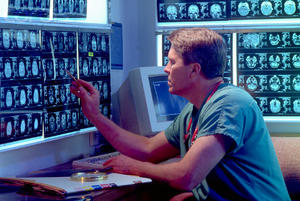In the trenchesCT scans help doctors treat sniper wounds
Determining a bullet or bomb fragment’s path through flesh and bone can help doctors treat injuries and decide which patients to prioritize; instead of relying solely on visual cues and a possibly deviated bullet path, researchers are working to develop high-resolution computed tomography (CT)-based methods of accurately determining a bullet’s trajectory

CT scans allow surgeons better results // Source: corbisimages.com
Determining a bullet or bomb fragment’s path through flesh and bone can help doctors treat injuries and decide which patients to prioritize. Instead of relying solely on visual cues and a possibly deviated bullet path, researchers are working to develop high-resolution computed tomography (CT)-based methods of accurately determining a bullet’s trajectory.
To try to produce a more quantifiable method, Les Folio, then at the Uniformed Services University in Bethesda, Maryland, and colleagues, asked a marksman to shoot six shots from a rifle at a distance of forty-five meters into each of two model legs. These were composed of various densities of rubber and plastic to simulate soft tissue and bone.
New Scientist reports that the researchers tilted the simulated limbs at six angles between shots, and then imaged them using high-resolution computed tomography (CT). Three radiologists independently estimated the trajectories of the bullets and the shooting angle using two methods. In one, they plotted the entrance and exit sites using coordinates taken from the scans and used these to calculate the angle. The other technique involved using software that allowed them to draw the estimated trajectory within the limb onto the on-screen image. Their estimates were all within 5 degrees of the actual shooting angles. Most were within 3 degrees.
This shows that CT-based methods can accurately determine a bullet’s trajectory, Folio says. Knowledge of the shooting angle could also be used to pinpoint a sniper’s location, and to determine the identity of the shooter in military investigations involving “friendly fire” incidents, when video footage or eyewitnesses are unavailable.
Paul Hazell of the Defense Academy of the United Kingdom in Shrivenham, Oxfordshire, says the usefulness of the technique depends on where the victim is shot, because bone can make a bullet deviate. “The bullet might also swerve before it gets to the body because of turbulence, friction and other forces acting upon it,” he says.
The technology for sniper detection systems is slightly further forward. The Boomerang system, developed in response to sniper threats to U.S. soldiers in Iraq and Afghanistan, uses a seven-microphone array mounted at the rear of military vehicles (“New system locates origin of incoming fire” 15 December 2008 HSNW). This detects the muzzle blast, the shock wave generated by incoming bullets and the difference in timing between the two, which is used to triangulate the position and elevation of the sniper within 1 second.
The system then alerts nearby soldiers. The U.S. Army has deployed some 8,000 Boomerang III units in Iraq and Afghanistan. A version called Warrior-X has also been developed for foot soldiers. Shoulder-Worn Acoustic Targeting System (SWATS) has also made it more difficult for snipers to ambush U.S. soldiers and live to escape (“Acoustic gunfire detection devices heading to the field” 28 February 2011 HSNW).
p
Boomerang has also been coupled with a well-established long-range surveillance system called LRAS3. This uses an infrared sensor, a GPS laser rangefinder - that uses lasers to calculate distance - and a video camera to find a sniper’s position using the signal from Boomerang. It then sends the information to units close by, reducing the time taken to return fire.
The obvious problem with such acoustic-based systems is that they rely on a shot already having been fired. The SLD500, made by French company CILAS and currently at the testing stage, uses laser scanning to detect the optical sights or goggles used by snipers to try to pinpoint them before they strike. It indicates the GPS position of possible snipers and can be coupled with thermal and video cameras, movement sensors and acoustic detectors to help confirm their identities.
